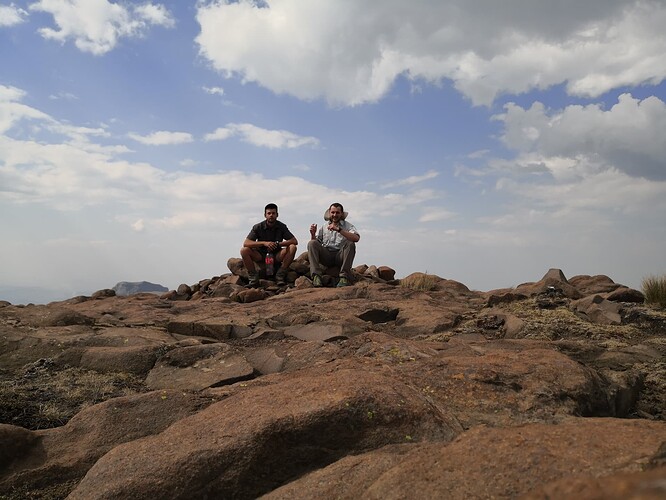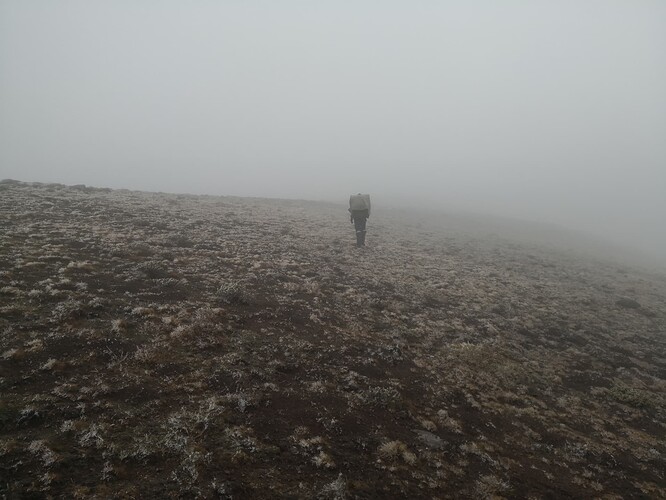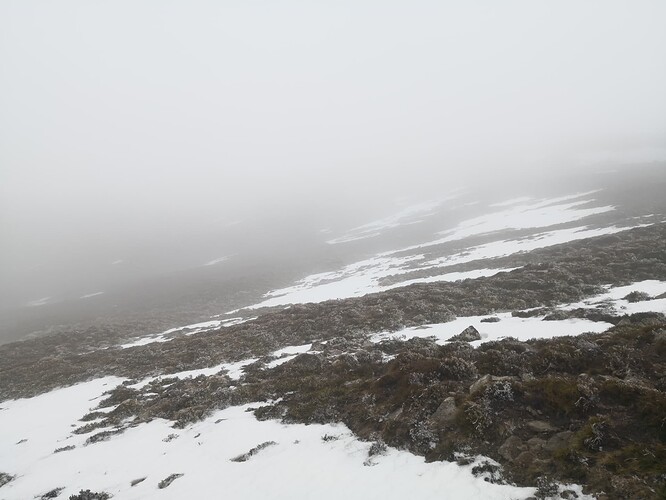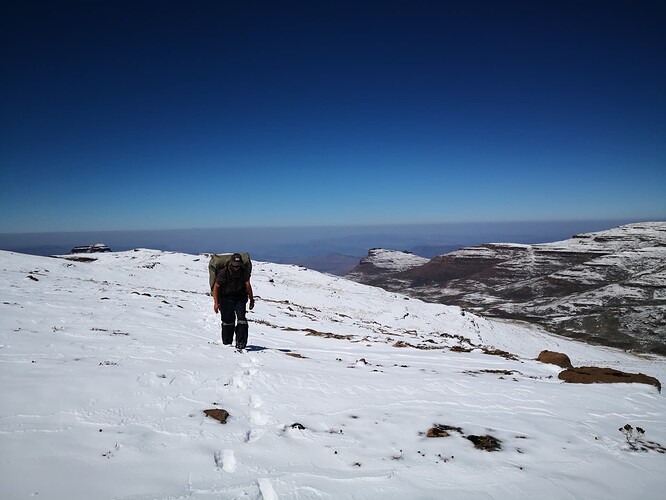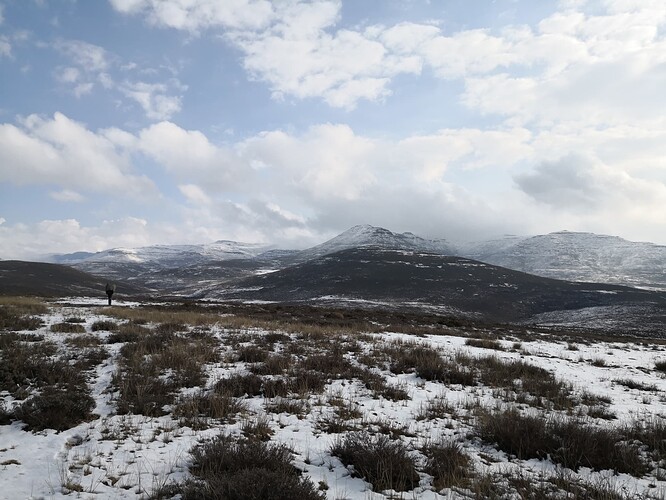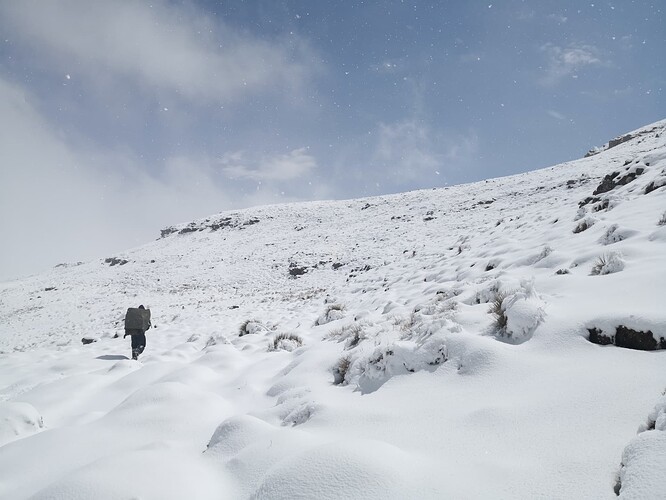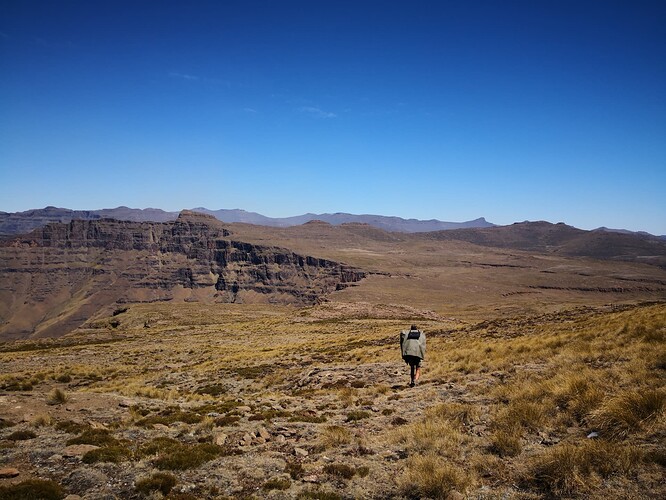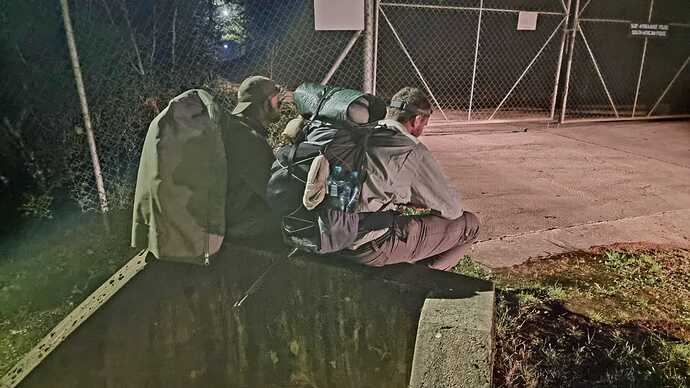Hi there,
So a friend and I recently completed our first Grand Traverse. I thought I might share a few impressions from our experience. The main purpose of this write up would be to possibly provide some meaningful guidance to those who are considering a GT.
I’ll start with a short summary (day by day) of our Traverse.
Day 1: a Good Start
Originally planned as a kind of Day Zero, this would be the day that we travelled from PTA down to Witsieshoek and started our hike. This ended up being more of a Day 1, as despite the fact that we only started off from the car park at about 12:30, we managed to make it quite a reasonable distance, setting up camp at about 18:00.
This day was quite a good one, and uneventful. As mentioned we started of from the Sentinel peak car park at about 12:30 and shot past the day hikers on the way up, soon finding ourselves alone at the chain ladders. Up we went and after some last calls and whatsapps at the top of the ladders we continued on to Mont-Aux-Sources. After a quick summit we went down into the valley on the other side (you’ll have to excuse my lack of knowledge of the valley and area names) continuing along the GT Record route (or one of the versions close to it). Progress was good and by 17:45-ish we started to set up camp on the Fangs Valley saddle (I think that what it’s called).
We felt really good at this point. We had attempted the GT for the first time earlier the year (around March) with slightly poorer physical preparation and MUCH heaver packs. Mine was over 25kg. On the first day we had an earlier start, hadn’t made it nearly as far and had suffered a lot more along the way. This time round we had done more appropriate training beforehand such as training with a weighted pack instead of just running. We had also lightened our packs quite a bit, mine was down to about 17kg (water included). I had also made a few key changes to my equipment such as switching from Lowa Renegades to Altra Lone Peaks (more about that later) which appeared to by paying off very well.
Day 2: Going well.
Day two started off well. We packed up camp after a good night of sleep and started off. It was ‘n pretty uneventful day and we made good progress, ultimately deciding to make it a day at the Kwakwatsi Shelter. After setting down packs I realised that we were actually quite close to Easter cave and decided to go check it out. After scouting ahead and finding the cave, and being very impressed by the prospect of overnighting there, we collected water down at the Kwakwatsi river and headed up to the cave for the night. This would be our best camp for the whole traverse.
Day 3: The winds of change
We started our day sitting in Easter Cave enjoying a magical Drakensberg east-facing-cave-sunrise. Truly an event that I will never forget. We bid the cave adieu and continued back down into the Kwakwatsi valley. We saw some other hikers on the other side of the valley, passing by them. Nothing more than a waved greeting as we had a Traverse to do! (Sorry if we were rude).
We travelled well, climbing the Elephant path quickly, enjoying the view. The last time we did that climb it was miserable experience, being in dense fog with the aforementioned heavy packs. We hiked past Tseketseke pass with a sense of relief, as this was where we had to exit our previous attempt. This would also mark the end of any prior knowledge of the route, as neither one of us had ever been far beyond Tseketseke.
We did a quick summit of Cleft Peak and enjoyed the view. The wind was beginning the become unpleasant though. After a somewhat difficult descent from Cleft Peak (we took a sub-optimal line) we also struggled a bit to find the correct route past the Ndumeni dome, having to resort to some hands-on near technical climbing to get to the correct path. That accomplished though, we continued through the Makhapung valley into Yodelers Cascades. Here we struggled to find a good camping spot that was both flat and not covered in dense brush. We eventually found a patch of ground that was “good enough” (the sun was setting) and set up camp as best we could. My setup wat quite a challenge on this particular day as I had brought a trekking pole tent (more on that later) and found it very difficult to get the tent pitched properly in such a way that it could perform well in the wind. That night the wind did come up quite a bit and I had to get up, and out, to fix loose pegs and reattach guy-lines etc. Not very pleasant.
It was also becoming increasingly cold. a Harbinger of things to come.
Day 4: The Winds have changed.
The day started overcast, windy, cold, with occasional bouts of rain. We broke camp, not even trying to get the tents dry. We started the ascent to the saddle between the Yodelers peaks and the real suffering started. The wind kicked into “crazy” and the intermittent rain turned into intermittent ice shards. I have no idea what the exact temperatures or windspeeds were, but it must have been 60kph plus, with a windchill well into to sub-zero’s. We had to try and dash for pockets of cover, trying to keep on the western-sides of the mountains. We seriously considered trying to reach a cave for cover, and we did see some on the map, but decided that we weren’t quite sure that we’d be able to actually find the caves, and so we pushed on. Luckily the route did generally flow just below the ridgeline on the western side, and so we did find some refuge from the worst of the wind. Making it to Champagne castle we left our bags and did a quick summit assault, staying as briefly as we could to get a few messages off with the phone-reception we found there.
Coming down from Champagne castle the conditions improved somewhat and we eventually made our campsite just past Leslie’s pass. It was actually still pretty early in the day and we would have liked to have summited Mafadi, but we could hear some thunder rolling in and weren’t quite sure about whether we would be able to find good shelter on or after Mafadi if things got bad.
Soon after setting up camp a thick cloudbank rolled in from the escarpment and reduced all visibility to about 2-3 meters. It was the right decision not to attempt Mafadi. Soon we also found ourselves in a light thunderstorm as well which continued intermittently throughout the night.
Day 5: Cold.
We woke to a damp, soggy, fog-filled world. Broke camp, packed up our soggy tents. Turns out SilNylon is quite the sponge. We started the climb up to Mafadi with poor visibility, about 40 meters, in the hope that it would improve as the day got on. Navigating solely via GPS we struggled onwards, getting turned around a few times, ending up on the wrong ridgeline somehow. The wind started picking up, but without improving the visibility, rather making it worse somehow.
The cold also became a significant issue again. The wind chill-factor being so bad that my phone (our primary source of navigation in the poor visibility) started having issues. The most disconcerting of which was a drastic reduction battery efficiency, with battery levels dropping a percentage every few seconds at some points. I tried to mitigate this by storing the phone in my jacket breast-pocket and taking it out only briefly. Nearing the summit the icy zephyr got so bad that I got frost burn on my nose. Eventually, though, we made the summit, determined the direction we should go to get down, and descended with haste.
Luckily, once again, descending into the valley provided much relief. Once down in the Sanqebethu valley the weather was pleasant and we moved quickly. Turning into the Jareteng valley we started the long climb towards Giants Castle.
We had encountered many Basotho people, their herds, as well as their dogs during the first days of our Traverse. These encounters had generally been quite friendly, and once a bit tense (we suspect that the men might have been escorting sheep recently “acquired”). After turning into the Jareteng valley we started passing quite close to a few huts. Some of these huts, as was often the case, were inhabited by a Basotho herder or two, and their dogs. What would usually happen is that the dogs would hear or see us coming at quite a distance and start barking. After a few moments the shepherd/s would come out and admonish the dogs, and we would continue on with a friendly greeting. However, when we were passing one particular hut we had gotten quite close when suddenly a pack of dogs burst out, with no shepherd to be seen. They stormed us, I threw a rock at one that was trying to get behind me, which fortunately made it retreat, my friend wasn’t quite as lucky. One of the dogs got a bite in on his ankle. Luckily he had a set of heavy rain-pants on and the bite only grazed the skin. I suspect that we had accidentally surprised the dogs and that this had resulted in their aggressive behaviour.
We continued up the seemingly endless Jareteng valley to finally set up camp just behind Katana peak. As we had climbed the weather had gotten windier and colder. We were quite grateful to finally be back in our (relatively) warm tents.
That night I heard what I initially thought was rain. After listening to it for a while a realised it didn’t sound quite right. I checked to see what it was, and lo and behold, it was snow! I was quite excited, initially, as this was the first time I’d ever seen or touched real snow. I lay back in my sleeping bag and dozed off with excited thoughts of the coming morning. Before dawn came, however, I woke up with the icy-cold tent wall pressing against my head the feet. Coming to, I realised that the snow (and it was snowing quite heavily now) was building up on the tent, causing it to sag. I beat on the tent walls from the inside to dislodge the snow, restoring the tent to its former glory, and went back to sleep. Soon, I woke again, finding the tent in the same saggy state as earlier. Repeating the process again I righted everything and went back to sleep. This would not be the end, however, and I found myself waking throughout the night every hour or so to repeat the process. Eventually the snow had piled up around the tent so much that beating the snow off from the inside wasn’t working anymore and I had to go out into the cold dark snowy night using my trusty ablutionary trowel as a snow-shovel to clear the walls of snow that had accumulated around the tent.
Day 6: Snow!
We woke to a world of white. The cloud cover was very low and visibility was poor (about 20 meters). The ground was covered in a pristine white blanket. It was surprisingly warm outside, and the world was strangely bright. We broke camp, which was surprisingly easy in the snow. I built my first snowman and threw a tentative snowball. It was all very surreal and exciting.
We started up towards Giants Saddle through the thick snow. Progress was slow but we made it nonetheless. As we climbed towards the saddle, however, visibility decreased. It had started snowing again, quite heavily with some wind as well. By the time we reached the top of the saddle we were in a full-blown blizzard. Barely able to see more than 5 meters, and only being able to see a sea of white snow even then, we decided to skip the Gaints Castle summit and cut behind it down into the next valley. If this discounts this from being a real Grand Traverse, then so be it. Using only the cellphone-GPS we carefully worked our way down other side of the saddle until we reached the top of Giants pass, and eventually we made our way onto the Lotheni bend. At this point the weather suddenly cleared up and we were greeted by the most beautiful sight of the snowy Drakensberg.
As we descended into the valley we sun came shining through, and the snow started melting very rapidly. By the time we had reached the valley floor things had become quite “sloshy”. Through the melting snow and mud we ran (walked quickly) along the path. Eventually coming to the Mokgothlong river, where we decided to make camp. There still was some daylight left but we decided that it wasn’t enough time to make the ascent to Thabana Ntlenyana.
It was very cold that night. The snow had started to melt, but had not gone completely and the snowmelt had left an icy residue on the ground. We had no choice but to set up our tents on the iced ground. That night things got so cold that our water bottles froze inside of our tents. We didn’t sleep much.
Day 7: Slippery white hell.
The icy dawn greeted us and we tried our best to break camp quickly, but the cold made it slow work. Cold hands don’t want to make knots and close clasps. Iced tent don’t go willingly into their stowage bags either.
Eventually we headed on and started the gradual ascent to Thabana Ntlenyana, going up the Thaba Putsoa valley. As we climbed however another problem became apparent. The surreal brightness of the previous day’s snow had burnt us quite badly. In my case my face and hands, and in my friend’s case, his eyes. He had developed arc-eyes and could barely see. As we climbed to higher and higher altitude the snow on the ground became thicker and thicker, and consequently the world became brighter and brighter. Even more so than the previous day because now the sun was shining in all it’s glory. My friend’s eyes became such a problem that he had to bind a handkerchief (we didn’t have sunglasses) over his forehead with some webbing to shield his eyes from the bright snow. This meant that he had about 30% vision and could only (and barely) see a few paces in front of him through the handkerchief. Seeing as my eyes didn’t hurt as much I took the lead and navigated us closer to our destination.
Things were becoming increasingly unpleasant. The snow was now so bright that it felt as if we were walking in a microwave. I tried to use a buff the cover as much of my face as possible, but my exposed hands and eyes were being fried by the bright reflected rays of snow-light. Our progress was also severely hampered by the now extremely slippery snow-melt. By now the snow had melted enough that everything was slippery and muddy, but not enough that we could clearly see the terrain beneath it. Every step was a wild guess, often resulting in a sudden destabilising foot-slide which had to be countered by every possible stabilising muscle available. This ascent up through snowy microwaving hell took us to the very edge of sanity.
After what seemed like an age, we had made our way up beyond the Thaba Putsoa valley past the shoulder and had started our ascent up to Thabana Ntlenyana proper. Here we also took a more direct route, because of the snow, and went straight up the peak next to Ntlenyana and walked on the ridgeline over to the summit of Thabana Ntlenyana itself. Descending was another (thankfully shorter) encounter with the slippery hell that I have come to associate with snowmelt. I bent both of my trekking poles.
As we descended into the Sani pass we thankfully, finally, dropped below the snow-line. We continued into the Sani pass and eventually set up camp a few km after crossing the tar road. My whole body felt like it had been put through a wringer. Every muscle ached from battling the constant slipping throughout the day.
Thankfully we camped very peacefully that night. It was a very cold night, but not as bad the night before.
Day 8: Carpe bonum diem
Each day after we had set up camp, we would discuss the day to come. And each day we would say “if the weather is good we will make it to such-and-so” and each day the weather was horrible. But on this morning of the eighth day we woke to a world drenched in nothing by sunlight and we knew our time had come.
We packed up camp, easily for once, and set off at a good trot. Days of pent up weather-related frustration could now finally be exorcized. We made good progress, making short work of the Sandleni saddle and ridge, soon going over the No Man’s saddle and peak. Rhino saddle was dealt with shortly, despite almost going down the wrong side of it. The Mashai saddle was a bit more taxing, especially because we had overshot it and tried to go over at the Bollard, which proved impossible. Soon enough, however, we were climbing up Walker’s saddle, and going down the Isicatula pass.
Things were getting dark by this stage but we decided to press on into the night. We had, had enough of this and were going to finish it NOW. We continued down into the (Thamatu?) valley and had a few strange encounters in the dark with the residents thereof. Turns out (which is understandable) that they are somewhat less friendly towards to strangers coming past their houses and their cattle in the dark. The darkness of the night was also now enhanced by a thick cloud of mist which had rolled into the valley.
Using the GPS we eventually found ourselves on the Thamatu pass, which is thankfully very easy to go down once your on it. And after what felt like an eternity of walking down that path in nothing but torchlight, we finally made it down to Bushmansneck. Or a large locked silver gate to be precise, but that’s were the post-Traverse story begins.
Gear
Now I’ll discuss a few key gear items that played an important role in my traverse. I’m going to categorize them from Absolute Hero, through Served Well But… , to Avoid if possible. I’m not affiliated with any of the manufacturers or vendors mentioned below and I do not receive any kind of commission from sales.
Absolute Hero
1. Freedom Ultralight Oryx (Prototype)
This pack helped me to shave about 1.4 kg off my base weight. My other pack is a Osprey Xenith 105 (which is great) but a lot more pack and weight than needed. The packs from Freedom Ultralight are still in development, but I’m seriously excited about them. They are made locally and at very reasonable prices. If you’ve ever needed a pack to enter the world of ultralight, this is it.
The owner @ChrisUL is a great guy and went to A LOT of trouble to get my pack just right for the Traverse, even adding in a special heavy-duty (still light) frame to handle the extra weight. There are many customization options available when ordering your pack. I utilized several of these to get the pack “GT ready”. These included having many easy access stowage pockets so that I could get to my snacks and GPS quickly. I also added a top strap for my tent and ground sheet and a system to quick-stow my trekking poles, all of which worked perfectly.
My pack came in at 52 litres. It was a very tight fit, but I eventually managed to fit 11 days (10 Day GT food plus day 0) worth of food and kit into it. If you’ve ever wanted proof that you don’t need a large back, this is it. If 52 litres is enough for a 10 day GT, then it’s going to be enough for anything else (at least in South-Africa).
2. Altra Lone peak 6 with Injinji toe-sock.
These shoes were amazing. Throughout the entire GT I did not get a single blister or hotspot on my feet. It felt as if I was hiking in slippers (but in a really good way).
They aren’t waterproof, but I found this to be a serious advantage. I could just walk straight through any river crossing and within 15 minutes my feet would be dry on the other side, even in colder weather.
I hiked through thick snow and varying degrees of snow-melt for three days and my feet were never overly cold. In the snow melt they did get quite cool, and my feet were basically permanently wet, but (and I suspect this is partly because of the Injinji toe socks) this caused absolutely no issues nor was it uncomfortable. By contrast, my friend’s heavy waterproof boots eventually soaked through as well and he developed serious wet-boot related issues.
The fact that the shoes weigh less combined than one of my Lowa Renegades also made a serious difference. I could hike faster and with less fatigue (more joy). Also, I love being able to feel more “engaged” in the walking process. These shoes, while having nice padding, allows me to feel a lot more tactile feedback from the terrain which in turn allowed me to walk very efficiently on tricky terrain.
These are zero-drop shoes, so they might not be for everyone. Do some research before switching, especially if you don’t spend a lot of time barefoot. But I’m now a firm believer in the idea of having stronger feet and less shoe. I could write several pages about why I believe less-shoe is the way to go, but I’m not going to do it here.
3. REI XeroDry Rain jacket
This Rain jacket that I bought a few years ago really shined on this hike. It kept me (relatively) warm during those crazy wind-chill ascents and dry throughout the constant rains and snows. I was very grateful that I had taken this.
4. Hungry Hiker meals
At the end of a long miserable day these meals provided a delicious comfort. I cannot recommend these strongly enough. My favourites would be the butter chicken and Thai green curry, but each dish that I’ve tried has been really good.
I’ve also found them to be the best-value for money at (at the time of writing) R95 per meal.
https://hungryhiker.co.za/product-category/hiking-meals/
5. PVM Octane and Reignite
I can recommend these very strongly. The Octane is a great energy boost during the day, and the Reignite makes a huge difference over the long run in terms of muscle fatigue and dehydration.
Served well but…
1. Huawei Mate 10 Prof with Locus Maps
I don’t own a dedicated GPS device, and so I decided to use my phone. Locus Maps with some custom datasets provided by the kind people of Vertical Ascent proved to be a quantum leap beyond what I used last time (Same phone but with just Wikiloc).
I created a custom map that indicated the GT route, as well as a lot of information of the peaks, valleys, passes, and caves. This worked brilliantly. I also paid for a silver membership on Locus Maps (quite cheap) in order to get contour-hillshading on the maps which also helped a lot.
Navigating with the phone generally worked quite well, except for four major issues:
a. When it got REALLY cold, the phone battery would start dying at an alarming rate.
b. I didn’t have enough battery life to live-track the whole Traverse, so I had to re-acquire the GPS lock every time I wanted to check our position. This could easily take a minute or two, which is really a pain when your navigating a tricky section and need to check you location often.
c. The days when we were in the snow, the ambient light was so bright that it was very hard to make out anything on the phone screen (even at max brightness).
d. Whilst the phone is quite good at getting an accurate location, it’s horrible at determining your orientation. This turned out be to be a great inconvenience when navigating in dense fog/mist/snowstorm as you had to basically “test walk” in a certain direction to try and figure out which way you were going on the map.
These issues are probably related to my phone specifically, but they are things to consider when choosing your navigation device. I’d highly recommend getting a phone that has some kind of good internal compass (to determine orientation) if there are such devices.
2. Lanshan 2
I bought this tent in order to save weight. On the previous GT attempt I had taken my trusty FA Starlight 2, which worked fine but came in at about 2.4 kg. The Lanshan is just over 1kg.
The tent didn’t fail as such. But I would not recommend it for Berg hikes (not up on the escarpment anyway). Being a trekking pole tent, it’s a lot more difficult to get set up properly, especially on uneven terrain, or terrain where the ground isn’t ideal for tent-pegs. With time and experience it becomes much easier to get the tent set up well, but this will always be an n+1 amount of effort in relation to a freestanding tent. The tent also has a huge footprint when you consider the area of the peg-lines as well.
The 15d Sil/Nylon outer fly is, in my opinion, just not sturdy enough the face the worst of the Berg winds. I was fortunate enough to not face winds of more then 30-40kph in mine, but I could just feel that those proper 60kph+ winds would cause serious issues, even with proper setup. The tent is also very noisy in the wind, and I ended up spending much of the night lying awake trying to listen for failing pegs or guylines (which did happen a few times).
The Sil/Nylon (I noticed) also tends to sag a lot as it gets cold and wet. This is an issue in a tent that depends wholly on these lines to stay upright. I would often go to sleep in ‘n perfectly set up tent, only to wake up with my feet touching the ice-cold inner wall because the tent had simply started to sag so much.
Apart from all of these things the tent did make it. So I might just be over-pessimistic, but in the future I’d really like to have something simpler and more bomb-proof that can provide some peace of mind after a long day, even if it’s a bit heavier.
3. Eiger Trek Ice Sleeping Bag
My trusty sleeping bag. Its comfort rating is -5c, or at least it was 10 years ago. I’m pretty sure it isn’t anymore. I’m definitely going to replace it before my next Upper Berg hike.
Avoid if possible.
1. Lack of Sunglasses
It’s not just for the sun. I still can’t see bright things properly. I hate snow.
2. Carrying an extra gas-cannister
I made the entire GT (7 days 11 hours) without emptying my small (110g gas) canister. I carried a full-size (230g gas) along all the way for nothing! I Made 1 cup of coffee in the morning, and dinner at night. If we had gone longer I would have finished the 110g, but even then I would have barely touched the 230g. In the future I would take only the 110g if you’re not going for longer than 7 days, and only the 230g if you’re planning on 7-12 days.
3. Not enough Biltong
I was really starting to feel that I needed a bit more protein. I had plenty of energy and salts (PVM Octane and reignite) but would have loved some more protein.
Lighterpack overview here: https://lighterpack.com/r/42zsgo
Conclusion
So this was supposed to be a very short write up. Oh well.
Our Grand Traverse wasn’t fun. It generally wasn’t enjoyable. It was the single most physically (and possibly mentally) demanding week of my life. But it was good.
